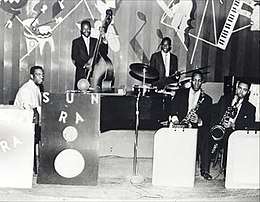Super-Sonic Jazz
Super-Sonic Jazz is an album by Sun Ra, recorded in 1956 at RCA Studios, Chicago. Super-Sonic Jazz was the first album to be released on Saturn Records, the label run by Sun Ra and Alton Abraham, and was one of only three albums by Sun Ra to have been available in the 1950s. (The other two are Jazz by Sun Ra, also released in 1957, and Jazz in Silhouette, released May 1959.)[1]
| Super-Sonic Jazz | ||||
|---|---|---|---|---|
 | ||||
| Studio album by Sun Ra and his Arkestra | ||||
| Released | March 1957[1] | |||
| Recorded | 1956, Chicago | |||
| Genre | Jazz | |||
| Length | 49:31 | |||
| Label | Saturn Impulse! Records Evidence | |||
| Producer | Alton Abraham | |||
| Sun Ra and his Arkestra chronology | ||||
| ||||
| Reissue cover | ||||
Impulse reissue, 1974 | ||||
| Review scores | |
|---|---|
| Source | Rating |
| Allmusic | |
| Rolling Stone | |
The album was retitled as Super-Sonic Sounds when it was reissued in 1974 by Impulse!, but reverted to its original title when it was released on CD by Evidence records in 1992.
El Saturn Research
Super-Sonic Jazz was the first album to be released on El Saturn Records, the label run by Sun Ra and his business partner Alton Abraham. Set up in 1955, they released their first singles, including a doo-wop group The Cosmic Rays[4] and the Arkestra's Saturn, at the beginning of 1956,[5] and had recorded the whole of their first album by the end of the year, to be released in March 1957. El Saturn is now considered, along with Charles Mingus and Max Roach’s Debut label and Harry Partch’s Gate 5 label, "one of the very first and most active artist-owned record labels."[6] Often pressed in editions of 75[7] — sometimes as few as 20 were made for specific concerts — the records would be manufactured using local black businesses, and often put together in Abraham's own home.[5] As John F. Szwed described,
El Saturn Records purchased no advertising, gave out no promotional copies for review, and no distribution channels except mail order, hand delivery to the record shops, and, in the southern tradition, sales from the bandstand after performances. An order to the El Saturn address might or might not get a response, and when a record came it might be a different one than ordered (a 1971 Saturn price list asked orderers to list five alternatives), or arrive months later.[8]
Track listing
12" Vinyl
All songs written by Sun Ra except "Soft Talk", written by Julian Priester;
Side A:
- "India" (4:52)
- "Sunology" (5:43)
- "Advice to Medics" (2:05)
- "Super Blonde" (2:39)
- "Soft Talk" (2:45)
- "Sunology, part II" (7:08)
Side B:
- "Kingdom of Not" (5:35)
- "Portrait of the Living Sky" (1:52)
- "Blues at Midnight" (6:34)
- "El is a Sound of Joy" (4:00)
- "Springtime in Chicago" (3:54)
- "Medicine for a Nightmare" (2:25)
Musicians

On "Springtime in Chicago", recorded at Balkan Studios, Chicago, April 13, 1956[1]
- Sun Ra – Piano, Electric Piano
- Art Hoyle – Trumpet, Percussion
- Julian Priester – Trombone
- James Scales – Alto Sax, Percussion
- John Gilmore – Percussion
- Pat Patrick – Baritone Sax, Percussion
- Wilburn Green – Electric Bass
- Robert Barry – Drums
On "Super Blonde", "Soft Talk", "Medicine for a Nightmare", and "Advice to Medics", recorded at RCA studios, possibly June 16, 1956:[1]
- Sun Ra – Piano, Electric Piano, 'Space Gong'
- Art Hoyle – Trumpet
- Julian Priester – Trombone
- John Gilmore – Tenor Sax
- Pat Patrick – Baritone Sax
- Wilburn Green – Electric Bass
- Robert Barry – Drums
- Jim Herndon – Tympani, Percussion
On "Kingdom of Not", "Portrait of The Living Sky", "Blues at Midnight", "El Is A Sound of Joy", "India", and "Sunology" (both parts), probably recorded at Balkan Studios, Chicago, September or October 1956:[1]
- Sun Ra – Piano, Electric Piano, 'Space Gong'
- Art Hoyle – Trumpet, Percussion
- Pat Patrick – Alto Sax, Percussion
- John Gilmore – Tenor Sax, Percussion
- Charles Davis – Baritone Sax, Percussion
- Victor Sproles – Bass
- William Cochran – Drums
- Jim Herndon – Tympani, Percussion
Mixed at RCA studios, Chicago, February 14, 1957, and released in March with an initial pressing of 500.[1]
References
- From Sunny Blount to Sun Ra; R Campbell:
- Wynn, Ron. "Super-Sonic Jazz Allmusic Review". Allmusic.
- Swenson, John (March 4, 1993). Review: Super-Sonic Jazz. Rolling Stone. Retrieved on 2010-10-10.
- Szwed, John F., "Space is the Place", Mojo, 2000, p. 152
- John Corbett Archived June 2, 2009, at the Wayback Machine
- Hyde Park Art Center, Chicago
- Talk, Alabama Jazz Hall of Fame, Campbell, 1995 retrieved 31-07-09
- Szwed, John F., "Space is the Place", Mojo, 2000, p. 170
External links
- Complete Sun Ra's Discography
- An Essay by John Corbett on Ra's Saturn label
- Pathways to Unknown Worlds: Sun Ra, El Saturn & Chicago's Afro-Futurist Underground, 1954-68, an exhibition about early Saturn activities
- A Review of Pathways to Unknown Worlds exhibition
- Saturn record catalogues from 1967 and 1969